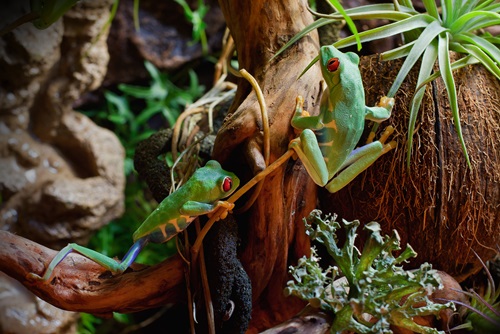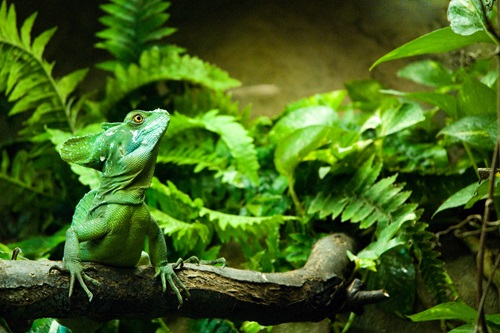How To Clean Your Reptile Tank
How a reptile or amphibian utilizes its habitat is similar to how we use our homes. They eat, sleep, relax, and explore throughout their enclosure. The biggest difference is that we can remove food and bathroom waste from the house quickly and easily with a flush of a toilet or by taking the garbage out. Since they can’t do this, that waste can build up without your help. Keeping waste picked up is important, but even if removed that waste can leave behind harmful bacteria. To help reduce the possibilities for bad bacteria causing your pet to get sick, cleaning and disinfection of the habitat are needed. Not every cleaning product for our homes is safe for our pets, so let’s take a quick dive into how to best clean and disinfect our pet’s home.
No Poop Left Behind
The easiest and most important piece of keeping your pet’s habitat clean and free of waste is to remove it, not just their poop, when you see it. Each time your pet goes to the bathroom, leaves behind some food, or you find a dead cricket, make sure to remove it and throw it away as soon as possible. In a humid environment these can grow many types of bacteria and fungus that aren’t good for your pet. The longer it’s left in the terrarium, the higher the chances are of your pet crawling over it and contacting those pathogens. To remove it you can use your hands or a Zilla Corner Litter Scoop, but make sure to remove all of the waste and the bedding around and under it. This should be done daily and make sure to immediately wash your hands and not touch anything after removing the waste. This is your best chance to remove any urine that may have soaked into the bedding. Once removed, replace it with a handful of clean bedding. If the waste is stuck to a piece of décor, remove the décor piece and wash it off with hot water, then replace it.

The Deep Clean!
While removing waste will help keep your pet’s habitat from smelling and reduce the potential for harmful pathogens, it still leaves behind small bits of waste. Many animals that burrow can also leave waste under the substrate where you may not see it. To keep waste from building up, it’s important to break down and sanitize the enclosure every two to three months. The best way to clean the enclosure is with clean hot water, and if you want to use a cleaning product stick to dish soap and elbow grease. Once cleaned off, you can sanitize your décor and terrarium with 10% bleach solution, then rinse with hot water and allow to dry.
Steps for Deep Cleaning
- Before you do anything, the most important thing is to remove your pet and place them in a secure container. Zilla’s Micro Habitats make a great temporary enclosure while cleaning. TIP: Add warm water to the container to allow them to soak while you’re cleaning.
- If you can easily move the terrarium near a sink it will help make cleaning easier, but be careful and don’t lift it alone. If you can’t move it, get a trash container and a storage bin and bring them near the enclosure.
- Turn off the lights and allow them to cool down before removing them to access the terrarium. Even if you don’t need to move them, still turn them off to avoid any splashing water or debris causing your bulb to break.
- Remove all of the décor and brush any stuck substrate back into the terrarium, then place it in the storage container. Once all of the décor is in the bin you can take them to a sink to clean. Clean them with hot water and dish soap then sanitize them with 10% bleach solution, rinse them, and allow them to dry.
- For the terrariums, remove and discard all of the bedding, then wipe out any remaining substrate. With a bucket of hot water and dish soap, scrub all interior surfaces of the enclosure. Rinse with clean water and allow to dry.
- To finish it off, use Zilla Terrarium Cleaner inside and out to give the glass a final shine and provide the best view possible of your pet. (If the terrarium is home to amphibians, do this step with warm clean water and nothing else.)
Once finished, move the empty terrarium back to its place. Now it’s time to reassemble the habitat. To start, add in new fresh substrate to a depth of about 2”. Feel free to add deeper areas to create hills and other gradients. Next, replace all of the décor and make sure that it is secure. Turn the lights back on and allow the terrarium to warm up for 20 minutes. Check your basking, warm side, and cool side temperatures to make sure they are correct and adjust the décor if needed. Once the temperatures are stable and within their needed range, introduce your pet to its new fresh clean home.

Their Health Is In Your Hands
Cleaning up poop and dead crickets, scrubbing urates off of branches, and trying to get stuck food off of fake plants are all probably on the bottom of your list of favorite things to do. However, it’s one of the most important pieces of husbandry and the health of your animal truly depends on it. Reptiles are quiet and don’t get your attention when they need to go outside or jump on you when they want to play like a dog would, so it’s up to us as their caretakers to give them enrichment and make sure their home is clean and safe. This is one of the keys to a happy and healthy life for your pet.
Please join our newsletter, connect with us on Facebook or contact us for more information.
